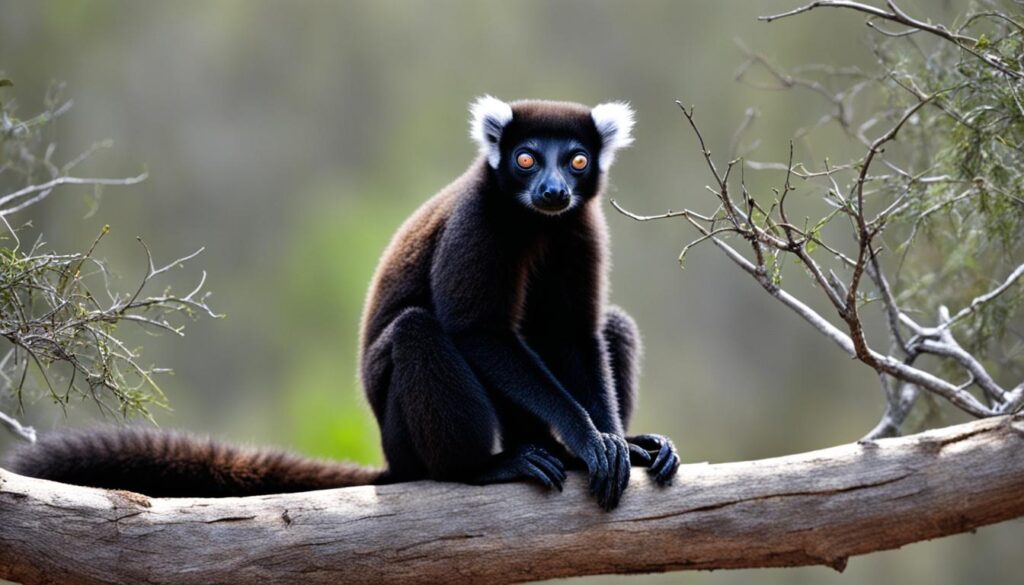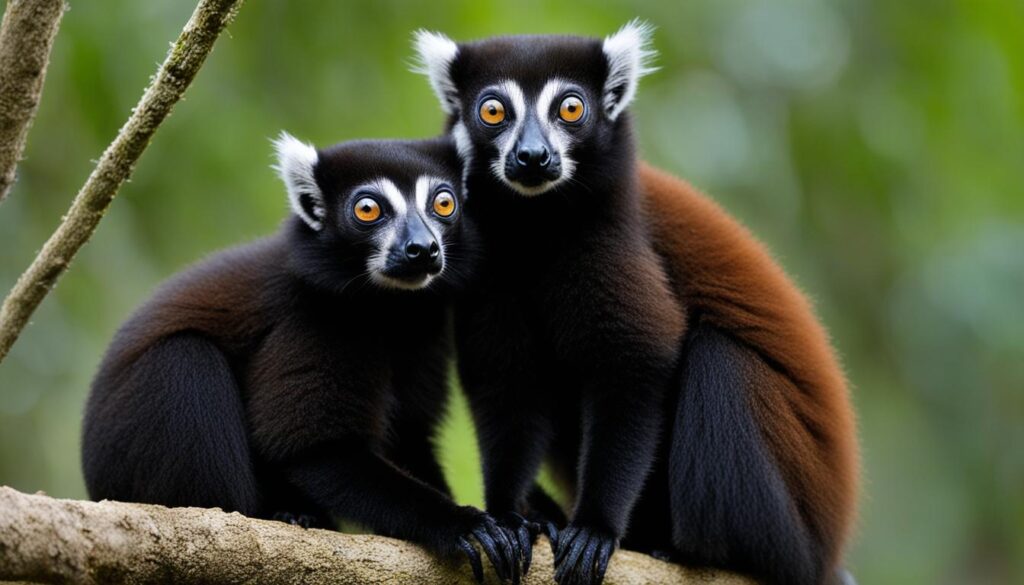Did you know the blue-eyed black lemur is highly endangered? There are fewer than 1,000 left in the wild. This primate, Eulemur flavifrons, lives only in northwestern Madagascar. It faces many threats to its survival.
What makes the blue-eyed black lemur stand out are its pretty blue eyes. Few primates, besides humans, have this feature. They help Madagascar’s forests by spreading seeds, which boosts biodiversity.
Yet, these lemurs deal with problems like deforestation, hunting, and losing their homes. But, there’s hope. People are working hard to save them. Efforts focus on protecting where they live, growing their numbers, and telling everyone about their situation.
Key Takeaways:
- The blue-eyed black lemur is an endangered primate species found in northwestern Madagascar.
- Distinctive for their blue eyes, these lemurs play a crucial role in seed dispersal in their habitat.
- They face threats such as deforestation, hunting, and habitat loss.
- Conservation efforts focus on protecting their habitats, increasing their population, and raising public awareness.
- Understanding and supporting these initiatives are essential for the long-term survival of this enchanting species.
Physical Characteristics
Male and female blue-eyed black lemurs look different. Males are all black. But, females are brownish grey or red with a dark muzzle.
These primates are small, about 38 inches long and five pounds. They are small compared to other primates.
You can easily spot blue-eyed black lemurs. They have long, bushy tails and a special “fox-like” face.
They move by walking on all fours or leaping in the trees. This helps them get around their forest home.
Blue-eyed black lemurs live about 18 years in the wild. But, in human care, they can live 20-25 years. This is because they are safe from predators and get good healthcare.
Comparison of Physical Characteristics:
| Physical Characteristics | Males | Females |
|---|---|---|
| Coat Color | Completely black | Brownish grey or red with a dark muzzle |
| Size | Average length of about 38 inches | Average length of about 38 inches |
| Weight | Around five pounds | Around five pounds |
| Tail | Long and bushy | Long and bushy |
| Muzzle | “Fox-like” muzzle | “Fox-like” muzzle |
Habitat and Diet
Blue-eyed black lemurs live in the trees of northwestern Madagascar’s lush forests. They are perfectly suited for life in these areas. These places provide them with everything they need, including shelter and food.
These lemurs eat a lot of fruits like figs and berries. Fruits are their favorite, which is part of their diverse diet. They also eat leaves, flowers, and insects. This varied eating helps spread seeds, which is vital for the forest’s health.
In captivity, they are given a mix of fruits, leaves, and special foods like monkey chow and dog chow. This diet ensures they stay healthy and get all their essential nutrients.
Blue-Eyed Black Lemur Diet Overview
| Food | Percentage of Diet |
|---|---|
| Fruit | 60% |
| Leaves | 25% |
| Flowers | 10% |
| Insects | 5% |
Social Behavior
Blue-eyed black lemurs are very social and live in groups of 7-15. They interact a lot, which makes their groups strong.
These lemurs use sounds a lot to talk to each other. They have different calls for finding friends, saying hi, showing off where they live, warning others, and when there’s danger.
They also talk through smells. With special scent glands on their wrists and chests, they label areas for their group and announce they’re around.
Females take the lead in blue-eyed black lemur groups. They get first dibs on food and who they mate with. They also make the big decisions in the group. This helps keep things working well.
When baby lemurs are born, everyone helps out. The group takes care of them together. Sometimes, twins are born, making the group even closer.
To sum up, these lemurs are all about working together. They talk with sounds and smells, let the females lead, and help raise each other’s young. This teamwork is key to their thriving and growing as a species.
Status in the Wild

The blue-eyed black lemur is in danger, with its population dropping fast. It’s marked as critically endangered by the IUCN. It’s also on appendix I of CITES. These show urgent need for conservation.
Deforestation is a major issue for these lemurs. It happens from slash-and-burn farming, logging, and mining. This destruction hurts where they can live and grow.
Lemurs are also hunted. People do this for food or to sell as pets. Sometimes farmers kill them to protect their crops. This speeds up their decline.
These problems make the blue-eyed black lemurs some of the most endangered primates. Less homes and being hunted puts them at a big risk. Their future is not looking good.
To help, there are steps in place. People work hard to make others aware of the lemurs’ status. They also study the lemurs in the wild. This helps us know how to best protect them.
Conservation Efforts
Conservation work is vital for saving the blue-eyed black lemur’s future. Places like zoos and research centers are working hard. They’re preventing this endangered animal from disappearing forever.
The Association of Zoos and Aquarium’s Prosimian Taxon Advisory Group and the Malagasy Fauna Interest Group lead this effort. They work with experts and others to come up with good plans. Their goal is to keep the blue-eyed black lemurs from becoming extinct.
The SSP, or Species Survival Plan, in AZA Zoos is a key program. It helps lemurs increase their numbers sustainably. This is done by carefully breeding them and making sure they are not too closely related. SSP aims for a healthy and diverse lemur population.
Researchers go to the lemurs’ habitats to learn important facts about them. They want to know how they live, where they live, and how many there are. This information helps in finding out what’s endangering them. It also guides efforts to save them.
Teaching the public about these lemurs is also important. It helps gain support and care for the lemurs. Events, campaigns, and zoo displays all help in this education. They show why it’s vital to protect the lemurs and their homes.
We can keep the blue-eyed black lemurs around by supporting conservation. It’s a chance to be part of something big and good. Together, we can make sure these awe-inspiring lemurs continue to live in the wild.
Breeding and Reproduction

Blue-eyed black lemurs have a unique way of caring for their young. They breed during a specific season, which is from April to June in Madagascar. In places like northern hemisphere locations, this happens from November to December. During this period, they use special behaviors to attract mates, like making sounds and showing off.
After mating, the female lemur carries her babies for about 126 days. She then gives birth to one or two lemurs in a cozy spot high in the trees. When they are born, both male and female baby lemurs look the same with an orange-brown fur. But as males grow, their fur turns completely black. Females, however, keep their original color.
The whole group of lemurs, called a band, helps take care of the babies. This teamwork is important for the babies’ health and learning how to be social. The band takes turns grooming, protecting, and playing with the young lemurs. This helps create a loving environment for their growth.
Female lemurs can have babies at about two years old, while males take a bit longer to be ready. When they can have offspring, they help their kind keep going. This marks the time when they grow from being teenagers to full-grown adults. They are then fully able to help increase their population.
Blue-Eyed Black Lemur Reproduction Facts
| Fact | Detail |
|---|---|
| Breeding Season | April to June in Madagascar, November to December in northern hemisphere locations |
| Gestation Period | Approximately 126 days |
| Offspring | One or two per birth |
| Coloration | Both genders born with orange-brown color, males turn black with age |
| Care and Participation | The entire group takes part in caring for and playing with the young |
| Sexual Maturity | Around two years for females, slightly longer for males |
Threats and Conservation Status
Blue-eyed black lemurs are in danger from several threats. These dangers include hunting, trapping, and losing their forests. They face these threats in part because they live in a small part of Madagascar. This makes it harder for them to avoid these dangers.
The IUCN has labeled them as critically endangered. This shows how urgent it is to save them from disappearing. They are found in Sahamalaza National Park, the only park created for their protection. But, even there, they are still at risk from wildfires and other dangers.
Less than 1,000 of these lemurs may be left in the wild. Efforts to save them focus on protecting where they live, stopping hunting, and telling people about their situation. These strategies are key to ensuring these lemurs have a future.
Hunting as a Threat
Hunting is a big danger for the blue-eyed black lemurs. People hunt them for food, which is reducing their numbers. Trapping makes things worse for them, putting them at a higher risk of disappearing.
Forest Destruction
Destroying forests also threatens these lemurs. Illegal cutting down of trees and farming techniques that burn the land destroy their homes. This loss of habitat takes away their food and shelter, forcing many lemurs out.
Conservation Status
Because of these serious threats, we need to act now to save the blue-eyed black lemurs. By protecting where they live, stopping hunting, and making more people aware, we can help these lemurs survive. This is crucial for these amazing creatures to live on for the future.
Conclusion
The blue-eyed black lemur is in danger and needs our help to survive. Many groups are working hard to keep them safe. This includes zoos, research centers, and organizations focused on conservation.
These lemurs are crucial to the balance of Madagascar’s nature. They help plants grow by spreading their seeds. But, they are so rare that we need to act fast to protect them.
It’s up to us to make sure these lemurs do not disappear forever. Helping those who work on their conservation is a great start. Let’s all join hands to protect these lemurs, ensuring they are here for our kids to see.








[…] in a variety of colors, including black, white, gray, and copper. Siberian Huskies have piercing blue or brown eyes that are almond-shaped and slightly […]